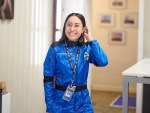Katya Echazarreta Gets Planetarium Named in Her Honor — Here’s Where

Katya Echazarreta, the first Mexican woman to travel into space on the Blue Origin NS-21 mission aboard the New Shepard spacecraft, inside an auditorium after the unveiling of a plaque and inauguration of a planetarium at Utopia Liberty that bears her name. (Photo by Gerardo Vieyra/NurPhoto via Getty Images)
A planetarium in Mexico City has been named after Katya Echazarreta, the first Mexican-born woman to travel to space.
The Katya Echazarreta Planetarium was opened inside the newly built Utopia Libertad, a park in the East side borough of Mexico City known as Itzapalapa. Along with the planetarium, the park, which is free to the public, includes a turtle farm, greenhouses, and gardens.
“We decided to build this planetarium with the best infrastructure so that Iztapalapa becomes a center for the promotion of science,” said Mayor Clara Brugada during the grand opening last week. “With this planetarium … thousands of girls and boys will learn what happens in space and will be able to be the initiators of a change of mentality, who will fall in love with being scientists and have examples like Katya.”
Brugada added that the planetarium would screen documentaries about space and planets on the roof of the theater. There will also be telescopes available for children to explore the stars in the nighttime sky.

This is the third planetarium in Mexico City. The other two are the Luis Enrique Erro Planetarium at the Instituto Politécnico Nacional and the José Herrán Planetarium on the main campus of the Universidad Nacional Autónoma de México.
Last summer, Echazarreta and five other citizen astronauts were launched more than 62 miles above the Earth’s surface on a Blue Origin rocket.
“Every time I try to sleep, I keep seeing Earth,” Echazarreta wrote on social media after her mission. “The curvature, the colors, the clouds … it’s changed my outlook on life.”
